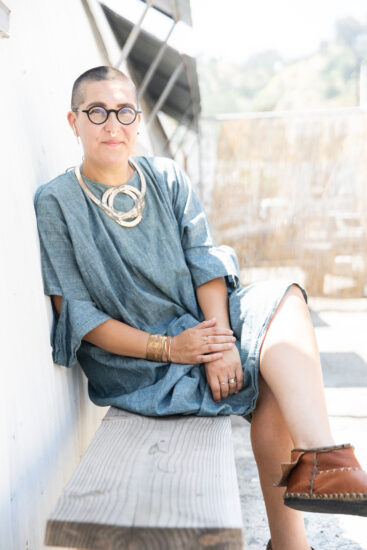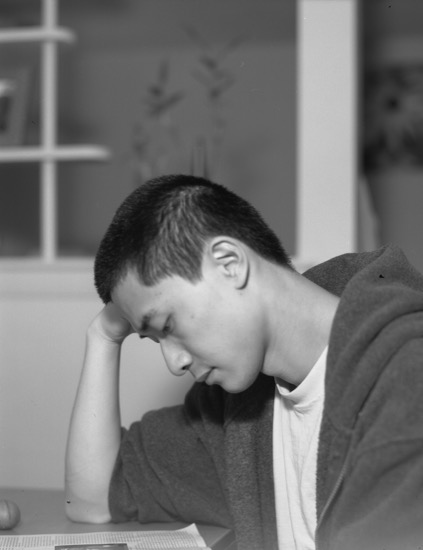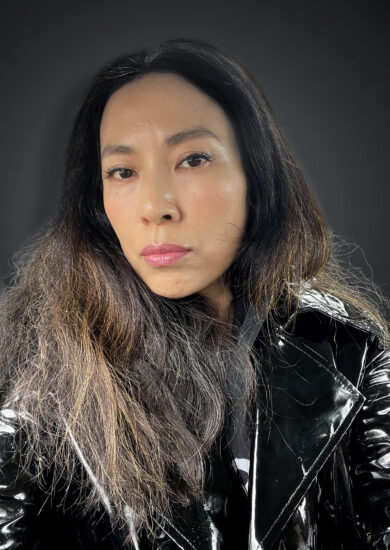
Artist Bios
 Tanya Aguiñiga was born in 1978 in San Diego, California, and raised in Tijuana, Mexico. An artist, designer, and craftsperson, Aguiñiga works with traditional craft materials like natural fibers and collaborates with other artists and activists to create sculptures, installations, performances, and community-based art projects. Drawing on her upbringing as a binational citizen, who daily crossed the border from Tijuana to San Diego for school, Aguiñiga’s work speaks of the artist’s experience of her divided identity and aspires to tell the larger and often invisible stories of the transnational community.
Tanya Aguiñiga was born in 1978 in San Diego, California, and raised in Tijuana, Mexico. An artist, designer, and craftsperson, Aguiñiga works with traditional craft materials like natural fibers and collaborates with other artists and activists to create sculptures, installations, performances, and community-based art projects. Drawing on her upbringing as a binational citizen, who daily crossed the border from Tijuana to San Diego for school, Aguiñiga’s work speaks of the artist’s experience of her divided identity and aspires to tell the larger and often invisible stories of the transnational community.
Aguiñiga began her career by creating collaborative installations with the Border Art Workshop/Taller de Arte Fronterizo, an artist collective that addressed political and human rights issues at the U.S.-Mexico border. The artist co-built and for six years ran a community center in Tijuana, aimed at bringing attention through arts initiatives to injustices that the local community faced. Aguiñiga has maintained this spirit of activism and community collaboration throughout her career, going on to create many performances and installations that involve the participation of other artists, activists, and community members. In her installations, furniture, and wearable designs, Aguiñiga often works with cotton, wool, and other textiles, drawing upon Mesoamerican weaving and traditional forms. In 2016, in response to the deep polarization about the U.S.-Mexico border, Aguiñiga created AMBOS (Art Made Between Opposite Sides), an ongoing series of projects that provides a platform for binational artists. Her inaugural AMBOS project, Border Quipu, used brightly colored strands of fabric to create quipu—an Andean pre-Columbian organizational system—that recorded the daily commutes to and from the United States.
Tanya Aguiñiga holds an MFA in furniture design from Rhode Island School of Design and a BA from San Diego State University. She is a United States Artists Target Fellow in the field of crafts and traditional arts, a National Association of Latino Arts and Cultures awardee, Creative Capital grant awardee, and a recipient of an Americans for the Arts Johnson Fellowship for Artists Transforming Communities. She has had major solo exhibitions at the Smithsonian American Art Museum, Washington, DC (2018); Museum of Arts and Design, New York (2018); among others. Her work has been included in exhibitions at Annenberg Space for Photography (2019) and Craft and Folk Art Museum, Los Angeles (2018), among others. Aguiñiga lives in Los Angeles, California.
 Onyeka Igwe is an artist and researcher working between cinema and installation, born and based in London, UK. Through her work, Onyeka is animated by the question — how do we live together? — with particular interest in the ways the sensorial, spatial and non-canonical ways of knowing can provide answers to this question. She uses embodiment, archives, narration and text to create structural ‘figure-of-eights’, a form that exposes a multiplicity of narratives. Her works have been shown in the UK and internationally at film festivals and galleries. She has an upcoming solo show at MoMA PS1 in Spring 2023. Onyeka was awarded the New Cinema Award at Berwick Film and Media Arts Festival 2019, 2020 Arts Foundation Fellowship Award for Experimental Film, 2021 Foundwork Artist Prize and has been nominated for the 2022 Jarman Award and Max Mara Artis Prize for Women.
Onyeka Igwe is an artist and researcher working between cinema and installation, born and based in London, UK. Through her work, Onyeka is animated by the question — how do we live together? — with particular interest in the ways the sensorial, spatial and non-canonical ways of knowing can provide answers to this question. She uses embodiment, archives, narration and text to create structural ‘figure-of-eights’, a form that exposes a multiplicity of narratives. Her works have been shown in the UK and internationally at film festivals and galleries. She has an upcoming solo show at MoMA PS1 in Spring 2023. Onyeka was awarded the New Cinema Award at Berwick Film and Media Arts Festival 2019, 2020 Arts Foundation Fellowship Award for Experimental Film, 2021 Foundwork Artist Prize and has been nominated for the 2022 Jarman Award and Max Mara Artis Prize for Women.
 Ken Liu is an American author of speculative fiction. A winner of the Nebula, Hugo, and World Fantasy awards for his fiction, he has also won top genre honors abroad in Japan, Spain, and France.
Ken Liu is an American author of speculative fiction. A winner of the Nebula, Hugo, and World Fantasy awards for his fiction, he has also won top genre honors abroad in Japan, Spain, and France.
Liu’s most characteristic work is the four-volume epic fantasy series, The Dandelion Dynasty, in which engineers, not wizards, are the heroes of a silkpunk world on the verge of modernity. His debut collection of short fiction, The Paper Menagerie and Other Stories, has been published in more than a dozen languages. A second collection, The Hidden Girl and Other Stories, followed. He also penned the Star Wars novel, The Legends of Luke Skywalker.
He’s often involved in media adaptations of his work. Recent projects include “The Message,” under development by 21 Laps and FilmNation Entertainment; “Good Hunting,” adapted as an episode in season one of Netflix’s breakout adult animated series Love, Death + Robots; and AMC’s Pantheon, with Craig Silverstein as executive producer, adapted from an interconnected series of Liu’s short stories.
Prior to becoming a full-time writer, Liu worked as a software engineer, corporate lawyer, and litigation consultant. He frequently speaks at conferences and universities on a variety of topics, including futurism, machine-augmented creativity, history of technology, bookmaking, and the mathematics of origami.
Liu lives with his family near Boston, Massachusetts.
 Rafael Lozano-Hemmer was born in Mexico City in 1967. In 1989 he received a B.Sc. in Physical Chemistry from Concordia University in Montréal, Canada. Media artist working at the intersection of architecture and performance art. He creates platforms for public participation using technologies such as robotic lights, digital fountains, computerized surveillance, media walls, and telematic networks. Inspired by phantasmagoria, carnival, and animatronics, his light and shadow works are "antimonuments for alien agency". He was the first artist to represent Mexico at the Venice Biennale with an exhibition at Palazzo Van Axel in 2007. He has also shown at Biennials in Cuenca, Havana, Istanbul, Kochi, Liverpool, Melbourne NGV, Moscow, New Orleans, New York ICP, Seoul, Seville, Shanghai, Singapore, Sydney, and Wuzhen. His public art has been commissioned for the Millennium Celebrations in Mexico City (1999), the Expansion of the European Union in Dublin (2004), the Student Massacre Memorial in Tlatelolco (2008), the Vancouver Olympics (2010), the pre-opening exhibition of the Guggenheim in Abu Dhabi (2015), and the activation of the Raurica Roman Theatre in Basel (2018). Collections holding his work include MoMA and Guggenheim in New York, TATE in London, MAC and MBAM in Montreal, Jumex, and MUAC in Mexico City, DAROS in Zurich, MONA in Hobart, 21C Museum in Kanazawa, Borusan Contemporary in Istanbul, CIFO in Miami, MAG in Manchester, SFMOMA in San Francisco, ZKM in Karlsruhe, SAM in Singapore and many others. He has received two BAFTA British Academy Awards for Interactive Art in London, a Golden Nica at the Prix Ars Electronica in Austria, "Artist of the year" Rave Award from Wired Magazine, a Rockefeller fellowship, the Trophée des Lumières in Lyon, an International Bauhaus Award in Dessau, the title of Compagnon des Arts et des Lettres du Québec in Quebec, and the Governor General's Award in Canada. He has lectured at Goldsmiths College, the Bartlett School, Princeton, Harvard, UC Berkeley, Cooper Union, USC, MIT MediaLab, Guggenheim Museum, LA MOCA, Netherlands Architecture Institute, Cornell, UPenn, SCAD, Danish Architecture Center, CCA in Montreal, ICA in London, and the Art Institute of Chicago. In the past two years, Lozano-Hemmer was the subject of 9 solo exhibitions worldwide, including a major show at the Hirshhorn Museum in Washington DC, the inaugural show at the AmorePacific Museum in Seoul, and a mid-career retrospective co-produced by the Musée d’Art Contemporain de Montréal and SFMOMA. In 2019 his immersive performance “Atmospheric Memory” premiered at the Manchester International Festival and his interactive installation “Border Tuner” connected people across the US-Mexico border using bridges of light controlled by the voices of participants in Ciudad Juárez, Chihuahua and El Paso, Texas.
Rafael Lozano-Hemmer was born in Mexico City in 1967. In 1989 he received a B.Sc. in Physical Chemistry from Concordia University in Montréal, Canada. Media artist working at the intersection of architecture and performance art. He creates platforms for public participation using technologies such as robotic lights, digital fountains, computerized surveillance, media walls, and telematic networks. Inspired by phantasmagoria, carnival, and animatronics, his light and shadow works are "antimonuments for alien agency". He was the first artist to represent Mexico at the Venice Biennale with an exhibition at Palazzo Van Axel in 2007. He has also shown at Biennials in Cuenca, Havana, Istanbul, Kochi, Liverpool, Melbourne NGV, Moscow, New Orleans, New York ICP, Seoul, Seville, Shanghai, Singapore, Sydney, and Wuzhen. His public art has been commissioned for the Millennium Celebrations in Mexico City (1999), the Expansion of the European Union in Dublin (2004), the Student Massacre Memorial in Tlatelolco (2008), the Vancouver Olympics (2010), the pre-opening exhibition of the Guggenheim in Abu Dhabi (2015), and the activation of the Raurica Roman Theatre in Basel (2018). Collections holding his work include MoMA and Guggenheim in New York, TATE in London, MAC and MBAM in Montreal, Jumex, and MUAC in Mexico City, DAROS in Zurich, MONA in Hobart, 21C Museum in Kanazawa, Borusan Contemporary in Istanbul, CIFO in Miami, MAG in Manchester, SFMOMA in San Francisco, ZKM in Karlsruhe, SAM in Singapore and many others. He has received two BAFTA British Academy Awards for Interactive Art in London, a Golden Nica at the Prix Ars Electronica in Austria, "Artist of the year" Rave Award from Wired Magazine, a Rockefeller fellowship, the Trophée des Lumières in Lyon, an International Bauhaus Award in Dessau, the title of Compagnon des Arts et des Lettres du Québec in Quebec, and the Governor General's Award in Canada. He has lectured at Goldsmiths College, the Bartlett School, Princeton, Harvard, UC Berkeley, Cooper Union, USC, MIT MediaLab, Guggenheim Museum, LA MOCA, Netherlands Architecture Institute, Cornell, UPenn, SCAD, Danish Architecture Center, CCA in Montreal, ICA in London, and the Art Institute of Chicago. In the past two years, Lozano-Hemmer was the subject of 9 solo exhibitions worldwide, including a major show at the Hirshhorn Museum in Washington DC, the inaugural show at the AmorePacific Museum in Seoul, and a mid-career retrospective co-produced by the Musée d’Art Contemporain de Montréal and SFMOMA. In 2019 his immersive performance “Atmospheric Memory” premiered at the Manchester International Festival and his interactive installation “Border Tuner” connected people across the US-Mexico border using bridges of light controlled by the voices of participants in Ciudad Juárez, Chihuahua and El Paso, Texas.
 Throughout his career, Tavares Strachan has engineered a multidisciplinary artistic practice that mobilizes our visual, intellectual, and emotional faculties. Aeronautical and astronomical science, deep-sea exploration, and extreme climatology are but some of the thematic arenas out of which Strachan creates monumental performative allegories that tell of cultural displacement, human aspiration, and mortal limitation. Strachan’s artistic practice and methodology often circumvents expected narratives, functioning in a more unconventional framework.
Throughout his career, Tavares Strachan has engineered a multidisciplinary artistic practice that mobilizes our visual, intellectual, and emotional faculties. Aeronautical and astronomical science, deep-sea exploration, and extreme climatology are but some of the thematic arenas out of which Strachan creates monumental performative allegories that tell of cultural displacement, human aspiration, and mortal limitation. Strachan’s artistic practice and methodology often circumvents expected narratives, functioning in a more unconventional framework.
One of Strachan’s most iconic projects was, The Distance Between What We Have and What We Want, 2006, for which he embarked on a journey to the Alaskan Arctic to excavate a 4.5-ton block of ice which was then transported via FedEx to his native Bahamas and displayed in a solar-powered freezer in the courtyard of his childhood elementary school. The piece is both physically arresting and metaphorically resonant, referencing the fragility of Earth’s homeostatic systems, the strange poetry of cultural and physical displacement, as well as the little-known contributions of Matthew Henson—an under-recognized American explorer and the co-discoverer of the North Pole.
On December 3, 2018, Strachan launched his project ENOCH into space. Created in collaboration with LACMA Art + Technology Lab, ENOCH is centered around the development and launch of a 3U satellite that brings to light the forgotten story of Robert Henry Lawrence Jr., the first African American astronaut selected for any national space program. The satellite launched via Spaceflight’s SSO-A: SmallSat Express mission from Vandenberg Air Force Base on a SpaceX Falcon 9 rocket. The sculpture will continue to circle the Earth for seven years in a sun-synchronous orbit.
Strachan was born in 1979 in Nassau, Bahamas, and currently lives and works between New York City and Nassau, Bahamas. He received a BFA in Glass from the Rhode Island School of Design in 2003 and an MFA in Sculpture from Yale University in 2006. Strachan’s ambitious and open-ended practice examines the intersection of art, science, and the environment, and has included collaborations with numerous organizations and institutions across the disciplines.
Strachan’s work has been featured in numerous solo exhibitions including You Belong Here, Prospect 3. Biennial, New Orleans; The Immeasurable Daydream, Biennale de Lyon, Lyon; Polar Eclipse, The Bahamas National Pavilion 55th Venice Biennale, Venice; Seen/Unseen, Undisclosed Exhibition, New York; Orthostatic Tolerance: It Might Not Be Such a Bad Idea if I Never Went Home Again, MIT List Visual Arts Center, Cambridge; among others.
He has been the recipient of numerous awards. In 2022, Strachan was awarded a MacArthur Fellowship for his research-based multidisciplinary practice. Other accolades include 2019-20 Artist in Residence at the Getty Research Institute, 2018 Frontier Art Prize, 2014 LACMA Art + Technology Lab Artist Grant, 2008 Tiffany Foundation Grant, 2007 Grand Arts Residency Fellowship, and 2006 Alice B. Kimball Fellowship.
 Informed by scientific research, biology, and perfumers, Anicka Yi has produced a unique body of work over the past decade at the intersection of politics and macrobiotics. Her practice questions the increasingly hazy taxonomic distinctions between what is human, animal, plant and machine, and is the result of an alchemical process of experimentation that explores often incompatible materials. She collaborates with researchers to create media that are often inherently political, and delves into the cultural conditioning of sense and perception in a way she describes as a "biopolitics of the senses." Her diverse installations, which draw on scientific concepts and techniques to activate vivid fictional scenarios, ask incisive questions about human psychology and the workings of society.
Informed by scientific research, biology, and perfumers, Anicka Yi has produced a unique body of work over the past decade at the intersection of politics and macrobiotics. Her practice questions the increasingly hazy taxonomic distinctions between what is human, animal, plant and machine, and is the result of an alchemical process of experimentation that explores often incompatible materials. She collaborates with researchers to create media that are often inherently political, and delves into the cultural conditioning of sense and perception in a way she describes as a "biopolitics of the senses." Her diverse installations, which draw on scientific concepts and techniques to activate vivid fictional scenarios, ask incisive questions about human psychology and the workings of society.
Yi's work has been the subject of numerous solo exhibitions at institutions around the world, including Pirelli HangarBicocca, Milan; Tate Modern, London; the Solomon R. Guggenheim Museum, New York; Fridericianum, Kassel, Germany; Kunsthalle Basel, Switzerland; List Visual Arts Center, MIT, Cambridge, Massachusetts; The Kitchen, New York; and the Cleveland Museum of Art, Cleveland, Ohio. Group exhibition venue highlights include the Museum of Modern Art, New York; Migros Museum fur Gegenwartskunst, Zürich, Switzerland; Walker Art Center, Minneapolis, Minnesota; Witte de With Contemporary Art, Rotterdam, The Netherlands; Fondation Louis Vuitton, Paris, France; Institute of Contemporary Art / Boston, Massachusetts; New Museum, New York; Palais De Tokyo, Paris, France; the 2017 Whitney Biennial, New York; K11 Art Foundation, Hong Kong; the 12th Biennale de Lyon; Studiolo, Zurich; MoCA, North Miami; Museum fur Gegenwartskunst, Basel; White Flag Projects, Saint Louis; SculptureCenter, New York and White Columns, New York, amongst others. In 2016, Yi was awarded the Hugo Boss Prize in recognition of the power and singularity of the experimental body of work she has produced over the past decade. Her work was featured in the 58th International Venice Biennale, titled May You Live In Interesting Times. Anicka Yi was awarded the 2020 Tate Turbine Hall Hyundai Commission.
Yi’s work is included in several public collections including the Solomon R. Guggenheim Museum, New York; Museum of Modern Art, New York; Aïshti Foundation, Jal el Dib, Lebanon; the Dikeou Collection, Denver; the Cleveland Museum of Art; Fondation d’entreprise Galeries Lafayette, Paris; the Julia Stoscheck Collection, Düsseldorf; the Los Angeles Country Museum of Art; the Rubell Family Collection; and the Whitney Museum of American Art.
Yi is represented by Gladstone Gallery and 47 Canal, New York.

Contact:
Stanford Arts Institute
artsinstitute@stanford.edu
